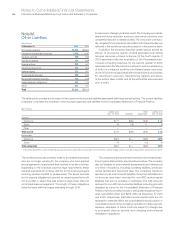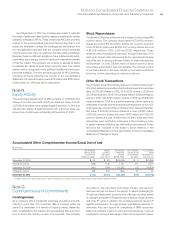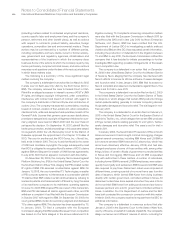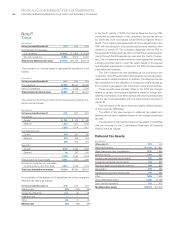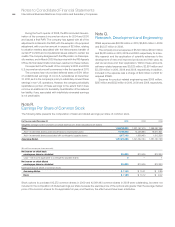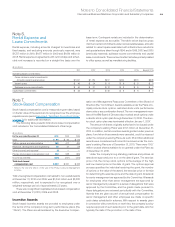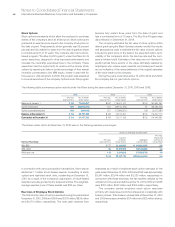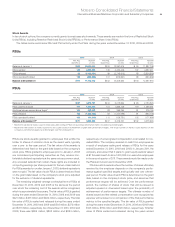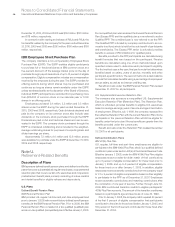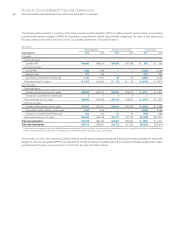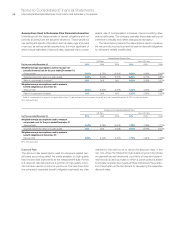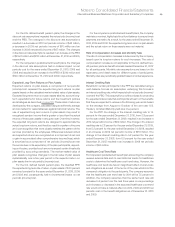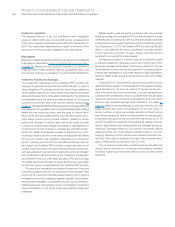IBM 2010 Annual Report Download - page 114
Download and view the complete annual report
Please find page 114 of the 2010 IBM annual report below. You can navigate through the pages in the report by either clicking on the pages listed below, or by using the keyword search tool below to find specific information within the annual report.Notes to Consolidated Financial Statements
International Business Machines Corporation and Subsidiary Companies112
the nonqualified plan was renamed the Excess Personal Pension
Plan (Excess PPP) and the qualified plan is now referred to as the
Qualified PPP. The combined plan is now referred to as the PPP.
The Qualified PPP is funded by company contributions to an irre-
vocable trust fund, which is held for the sole benefit of participants
and beneficiaries. The Excess PPP, which is unfunded, provides
benefits in excess of IRS limitations for qualified plans.
Benefits provided to the PPP participants are calculated using
benefit formulas that vary based on the participant. Pension
benefits are calculated using one of two methods based upon
specified criteria used to determine each participant’s eligibility.
The first method uses a five-year, final pay formula that determines
benefits based on salary, years of service, mortality and other
participant-specific factors. The second method is a cash balance
formula that calculates benefits using a percentage of employees’
annual salary, as well as an interest crediting rate.
Benefit accruals under the IBM Personal Pension Plan ceased
December 31, 2007 for all participants.
U.S. Supplemental Executive Retention Plan
The company also sponsors a nonqualified U.S. Supplemental
Exec utive Reten tion Plan (Retention Plan). The Retention Plan,
which is unfunded, provides benefits to eligible U.S. executives
based on average earnings, years of service and age at termination
of employment. Effective July 1, 1999, the company replaced the
then effective Retention Plan with the current Retention Plan. Some
participants in the previous Retention Plan will still be eligible for
benefits under that prior plan if those benefits are greater than the
benefits provided under the current plan.
Benefit accruals under the Retention Plan ceased December
31, 2007 for all participants.
Defined Contribution Plans
IBM 401(k) Plus Plan
U.S. regular, full-time and part-time employees are eligible to
participate in the IBM 401(k) Plus Plan, which is a qualified defined
contribution plan under section 401(k) of the Internal Revenue Code.
Effective January 1, 2008, under the IBM 401(k) Plus Plan, eligible
employees receive a dollar-for-dollar match of their contributions
up to 6 percent of eligible compensation for those hired prior to
January 1, 2005, and up to 5 percent of eligible compensation
for those hired on or after January 1, 2005. In addition, eligible
employees receive automatic contributions from the company equal
to 1, 2 or 4 percent of eligible compensation based on their eligibility
to participate in the PPP as of December 31, 2007. Employees
receive automatic contributions and matching contributions after
the completion of one year of service. Further, through June 30,
2009, IBM contributed transition credits to eligible participants’
401(k) Plus Plan accounts. The amount of the transition credits was
based on a participant’s age and service as of June 30, 1999.
Prior to January 1, 2008, the company match equaled 50 percent
of the first 6 percent of eligible compensation that participants
contributed to the plan for those hired before January 1, 2005, and
100 percent of the first 6 percent contributed for those hired after
December 31, 2004.
December 31, 2010, 2009 and 2008 was $153 million, $120 million
and $78 million, respectively.
In connection with vesting and release of RSUs and PSUs, the
tax benefits realized by the company for the years ended December
31, 2010, 2009 and 2008 were $293 million, $156 million and $165
million, respectively.
IBM Employees Stock Purchase Plan
The company maintains a non-compensatory Employees Stock
Pur chase Plan (ESPP). The ESPP enables eligible participants
to purchase full or fractional shares of IBM common stock at a
five-percent discount off the average market price on the day of
purchase through payroll deductions of up to 10 percent of eligible
compensation. Eligible compensation includes any compensation
received by the employee during the year. The ESPP provides for
offering periods during which shares may be purchased and
continues as long as shares remain available under the ESPP,
unless terminated earlier at the discretion of the Board of Directors.
Individual ESPP participants are restricted from purchasing more
than $25,000 of common stock in one calendar year or 1,000
shares in an offering period.
Employees purchased 2.4 million, 3.2 million and 3.5 million
shares under the ESPP during the years ended December 31,
2010, 2009 and 2008, respectively. Cash dividends declared and
paid by the company on its common stock also include cash
dividends on the company stock purchased through the ESPP.
Dividends are paid on full and fractional shares and can be rein-
vested in the ESPP. The company stock purchased through the
ESPP is considered outstanding and is included in the weighted-
average outstanding shares for purposes of computing basic and
diluted earnings per share.
Approximately 7.2 million, 9.6 million and 12.8 million shares
were available for purchase under the ESPP at December 31, 2010,
2009 and 2008, respectively.
Note U.
Retirement-Related Benefits
Description of Plans
IBM sponsors defined benefit pension plans and defined contribution
plans that cover substantially all regular employees, a supplemental
retention plan that covers certain U.S. executives and nonpension
postretirement benefit plans primarily consisting of retiree medical
and dental benefits for eligible retirees and dependents.
U.S. Plans
Defined Benefit Pension Plans
IBM Personal Pension Plan
IBM provides U.S. regular, full-time and part-time employees hired
prior to January 1, 2005 with noncontributory defined benefit pension
benefits via the IBM Personal Pension Plan. Prior to 2008, the IBM
Personal Pension Plan consisted of a tax qualified (qualified) plan
and a non-tax qualified (nonqualified) plan. Effective January 1, 2008,


